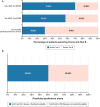The value of knowing: preferences for genetic testing to diagnose rare muscle diseases
- PMID: 38649872
- PMCID: PMC11036564
- DOI: 10.1186/s13023-024-03160-7
The value of knowing: preferences for genetic testing to diagnose rare muscle diseases
Abstract
Background: Genetic testing can offer early diagnosis and subsequent treatment of rare neuromuscular diseases. Options for these tests could be improved by understanding the preferences of patients for the features of different genetic tests, especially features that increase information available to patients.
Methods: We developed an online discrete-choice experiment using key attributes of currently available tests for Pompe disease with six test attributes: number of rare muscle diseases tested for with corresponding probability of diagnosis, treatment availability, time from testing to results, inclusion of secondary findings, necessity of a muscle biopsy, and average time until final diagnosis if the first test is negative. Respondents were presented a choice between two tests with different costs, with respondents randomly assigned to one of two costs. Data were analyzed using random-parameters logit.
Results: A total of 600 online respondents, aged 18 to 50 years, were recruited from the U.S. general population and included in the final analysis. Tests that targeted more diseases, required less time from testing to results, included information about unrelated health risks, and were linked to shorter time to the final diagnosis were preferred and associated with diseases with available treatment. Men placed relatively more importance than women on tests for diseases with available treatments. Most of the respondents would be more willing to get a genetic test that might return unrelated health information, with women exhibiting a statistically significant preference. While respondents were sensitive to cost, 30% of the sample assigned to the highest cost was willing to pay $500 for a test that could offer a diagnosis almost 2 years earlier.
Conclusion: The results highlight the value people place on the information genetic tests can provide about their health, including faster diagnosis of rare, unexplained muscle weakness, but also the value of tests for multiple diseases, diseases without treatments, and incidental findings. An earlier time to diagnosis can provide faster access to treatment and an end to the diagnostic journey, which patients highly prefer.
Keywords: Diagnosis; Discrete-choice experiment; Genetic test; Neuromuscular disease; Pompe disease; Screening.
© 2024. The Author(s).
Conflict of interest statement
CM is a full-time employee of RTI Health Solutions, an independent nonprofit research organization, which received funding pursuant to a contract from Sanofi to conduct the study that is the subject of this manuscript. MB and JC were employees of RTI Health Solutions at the time the study was conducted. SS, KAH, and AH are employees of Sanofi and may hold shares and/or stock options in the company. EB was an employee of Sanofi at the time the study was conducted and may hold shares and/or stock options in the company.
Figures


Similar articles
-
Late-onset Pompe disease is prevalent in unclassified limb-girdle muscular dystrophies.Mol Genet Metab. 2013 Nov;110(3):287-9. doi: 10.1016/j.ymgme.2013.08.005. Epub 2013 Aug 15. Mol Genet Metab. 2013. PMID: 24011652
-
The value of diagnostic testing for parents of children with rare genetic diseases.Genet Med. 2019 Dec;21(12):2798-2806. doi: 10.1038/s41436-019-0583-1. Epub 2019 Jun 26. Genet Med. 2019. PMID: 31239560
-
Identification of GAA variants through whole exome sequencing targeted to a cohort of 606 patients with unexplained limb-girdle muscle weakness.Orphanet J Rare Dis. 2017 Nov 17;12(1):173. doi: 10.1186/s13023-017-0722-1. Orphanet J Rare Dis. 2017. PMID: 29149851 Free PMC article.
-
A Systematic Review of Discrete Choice Experiments and Conjoint Analysis on Genetic Testing.Patient. 2022 Jan;15(1):39-54. doi: 10.1007/s40271-021-00531-1. Epub 2021 Jun 4. Patient. 2022. PMID: 34085205
-
The Use of Bone Biomarkers, Imaging Tools, and Genetic Tests in the Diagnosis of Rare Bone Disorders.Calcif Tissue Int. 2025 Jan 22;116(1):32. doi: 10.1007/s00223-024-01323-z. Calcif Tissue Int. 2025. PMID: 39841287 Review.
Cited by
-
Comparative genetic diagnostic evaluation of pediatric neuromuscular diseases in a consanguineous population.Sci Rep. 2025 Jan 2;15(1):231. doi: 10.1038/s41598-024-81744-w. Sci Rep. 2025. PMID: 39747233 Free PMC article.
References
-
- Grigull L, Lechner W, Petri S, Kollewe K, Dengler R, Mehmecke S, et al. Diagnostic support for selected neuromuscular diseases using answer-pattern recognition and data mining techniques: a proof of concept multicenter prospective trial. BMC Med Inf Decis Mak. 2016;16:31. doi: 10.1186/s12911-016-0268-5. - DOI - PMC - PubMed
-
- Kassardjian CD, Amato AA, Boon AJ, Childers MK, Klein CJ, Committee APP. The utility of genetic testing in neuromuscular disease: a consensus statement from the AANEM on the clinical utility of genetic testing in diagnosis of neuromuscular disease. Muscle Nerve. 2016;54(6):1007–9. doi: 10.1002/mus.25387. - DOI - PubMed
Publication types
MeSH terms
Grants and funding
LinkOut - more resources
Full Text Sources
Medical

